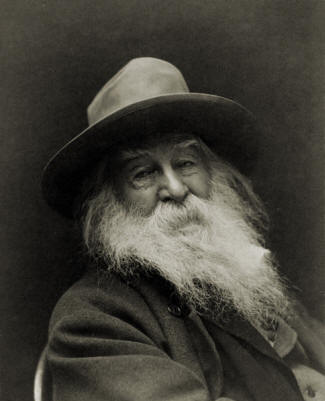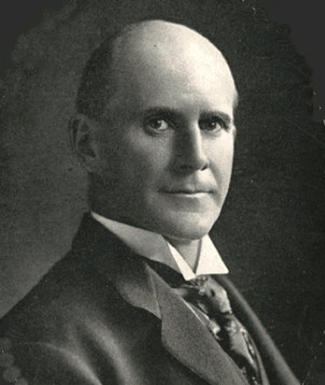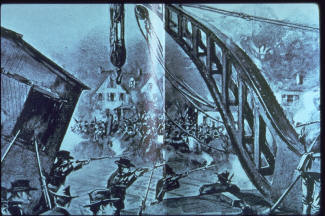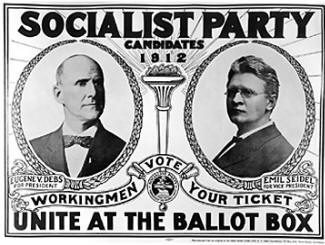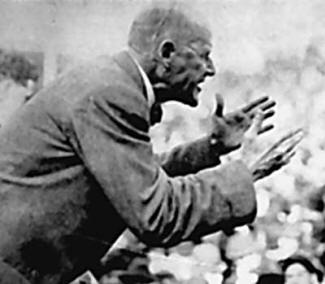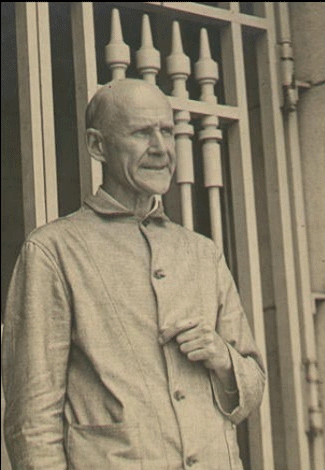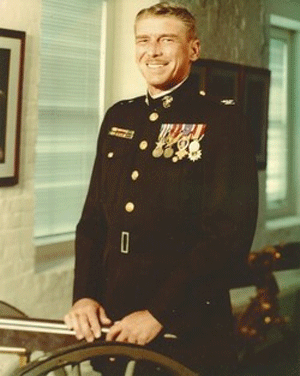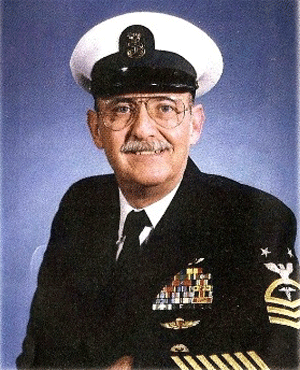USS Pueblo (AGER-2)by Wikipedia
Accessed 12/8/17
NOTICE: THIS WORK MAY BE PROTECTED BY COPYRIGHTYOU ARE REQUIRED TO READ
THE COPYRIGHT NOTICE AT THIS LINK BEFORE YOU READ THE FOLLOWING WORK, THAT IS AVAILABLE SOLELY FOR PRIVATE STUDY, SCHOLARSHIP OR RESEARCH PURSUANT TO 17 U.S.C. SECTION 107 AND 108. IN THE EVENT THAT THE LIBRARY DETERMINES THAT UNLAWFUL COPYING OF THIS WORK HAS OCCURRED, THE LIBRARY HAS THE RIGHT TO BLOCK THE I.P. ADDRESS AT WHICH THE UNLAWFUL COPYING APPEARED TO HAVE OCCURRED. THANK YOU FOR RESPECTING THE RIGHTS OF COPYRIGHT OWNERS.

Pueblo in North Korea, 2012
History
United States
Name: Pueblo
Namesake: Pueblo, Colorado and Pueblo County, Colorado
Builder: Kewaunee Shipbuilding and Engineering
Laid down: 1944
Launched: 16 April 1944
Commissioned: 7 April 1945
In service: 1945
Reclassified:
18 June 1966, AKL-44
13 May 1967, AGER-2
Honors and
awards:
National Defense Service Medal
Korean Defense Service Medal
Combat Action Ribbon (retroactive)
Captured: 23 January 1968
Fate: Captured by North Korea
Status: Active, in commission (to prevent seizure, currently held by North Korea as a museum ship)
Badge: USS Pueblo AGER-2 Crest.png
General characteristics
Class and type:
(As built) Army Freight and Supply (FS)
(Initial Navy) Camano-class light cargo ship (AKL)
(As converted) Banner-class environmental research ship
Type: (As built) Light Cargo Ship; (As converted) Intel-Gathering Vessel
Displacement: 550 tons light, 895 tons full, 345 tons dead
Length: 177 ft (54 m)
Beam: 32 ft (9.8 m)
Draft: 9 ft (2.7 m)
Propulsion: Two 500hp GM Cleveland Division 6-278A 6-cyl V6 Diesel engines
Speed: 12.7 knots (23.5 km/h; 14.6 mph)
Complement: 6 officers, 70 men
Armament: 2 × M2 Browning .50-caliber machine guns
USS Pueblo (AGER-2) is a Banner-class environmental research ship, attached to Navy intelligence as a spy ship, which was attacked and captured by North Korean forces on 23 January 1968, in what is known today as the "Pueblo incident" or alternatively, as the "Pueblo crisis".
The seizure of the U.S. Navy ship and its 83 crew members, one of whom was killed in the attack, came less than a week after President Lyndon B. Johnson's State of the Union address to the United States Congress, a week before the start of the Tet Offensive in South Vietnam during the Vietnam War, and three days after 31 men of North Korea's KPA Unit 124 had crossed the Korean Demilitarized Zone (DMZ) and killed 26 South Koreans in an attempt to attack the South Korean Blue House (executive mansion) in the capital Seoul. The taking of Pueblo and the abuse and torture of its crew during the subsequent 11-month prisoner drama became a major Cold War incident, raising tensions between the western democracies and the Soviet Union and China.
North Korea stated that Pueblo deliberately entered their territorial waters 7.6 nautical miles (14 km) away from Ryo Island, and that the logbook shows that they intruded several times.[1] However, the United States maintains that the vessel was in international waters at the time of the incident and that any purported evidence supplied by North Korea to support its statements was fabricated.[2]
Pueblo, still held by North Korea today, officially remains a commissioned vessel of the United States Navy.[3] Since early 2013, the ship has been moored along the Potong River in Pyongyang, and used there as a museum ship at the Pyongyang Victorious War Museum.[4] Pueblo is the only ship of the U.S. Navy still on the commissioned roster currently being held captive.[5]
Initial operations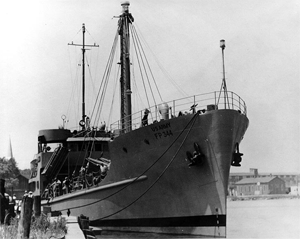 U.S. Army Cargo Vessel FP-344 (1944). Transferred to the Navy in 1966, she became USS Pueblo (AGER-2)
U.S. Army Cargo Vessel FP-344 (1944). Transferred to the Navy in 1966, she became USS Pueblo (AGER-2)The ship was launched at the Kewaunee Shipbuilding and Engineering Company in Kewaunee, Wisconsin, on 16 April 1944, as the United States Army Freight and Passenger (FP) FP-344. The Army later redesignated the FP vessels as Freight and Supply changing the designation to FS-344.[6] The ship, commissioned at New Orleans on 7 April 1945, served as a Coast Guard–manned Army vessel used for training civilians for the Army. Her first commanding officer was Lt. J. R. Choate, USCGR, succeeded by Lt. J.G. Marvin B. Barker, USCGR, on 12 September 1945.[7] FS-344 was placed out of service in 1954.
FS-344 was transferred to the United States Navy on 12 April 1966 and was renamed USS Pueblo (AKL-44) after Pueblo and Pueblo County, Colorado on 18 June of the same year.
Initially, she served as a light cargo ship, but shortly after resuming service was converted to an intelligence gathering ship, or what is colloquially known as a "spy ship", and redesignated AGER-2 on 13 May 1967.
Pueblo incidentOn 5 January 1968, Pueblo left U.S. Navy base Yokosuka, Japan, in transit to the U.S. naval base at Sasebo, Japan; from there she left on 11 January 1968, headed northward through the Tsushima Strait into the Sea of Japan. She left with specific orders to intercept and conduct surveillance of Soviet Navy activity in the Tsushima Strait and to gather signal and electronic intelligence from North Korea.[8] The declassified SIGAD for the National Security Agency (NSA) Direct Support Unit (DSU) from the Naval Security Group (NSG) on Pueblo during the patrol involved in the incident was USN-467Y.[9] AGER (Auxiliary General Environmental Research) denoted a joint Naval and National Security Agency (NSA) program.[10]
At 17:30 on 20 January 1968, a North Korean modified SO-1 class Soviet style submarine chaser passed within 4,000 yards (3.7 km) of Pueblo, which was about 15.4 miles (24.8 km) southeast of Mayang-do at a position 39°47'N and 128°28.5'E.[11]
In the afternoon of 22 January 1968, the two North Korean fishing trawlers Rice Paddy 1 and Rice Paddy 2 passed within 30 yards (27 m) of Pueblo. That day, a North Korean unit made an assassination attempt in the "Blue House" executive mansion against the South Korean President Park Chung-hee, but the crew of Pueblo were not informed.[11]
According to the American account, the following day, 23 January, Pueblo was approached by a submarine chaser and her nationality was challenged; Pueblo responded by raising the U.S. flag. The North Korean vessel then ordered it to stand down or be fired upon. Pueblo attempted to maneuver away, but was considerably slower than the submarine chaser. Several warning shots were fired. Additionally, three torpedo boats appeared on the horizon and then joined in the chase and subsequent attack.
The attackers were soon joined by two MiG-21 fighters. A fourth torpedo boat and a second submarine chaser appeared on the horizon a short time later. The ammunition on Pueblo was stored belowdecks, and her machine guns were wrapped in cold weather tarpaulins. The machine guns were unmanned, and no attempt was made to man them. An NSA report quotes the sailing order:
(...) Defensive armament (machine guns) should be stowed or covered in such manner so that it does not cause unusual interest by surveyed units. It should be used only in the event of a threat to survival (...)
and notes
In practice, it was discovered that, because of the temperamental adjustments of the firing mechanisms, the .50-caliber machine guns took at least ten minutes to activate. Only one crew member, with former army experience, had ever had any experience with such weapons, although members of the crew had received rudimentary instructions on the weapons immediately prior to the ship's deployment.[11]
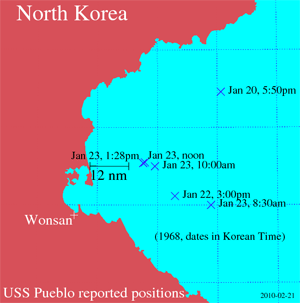 Reported positions of USS Pueblo
Reported positions of USS Pueblo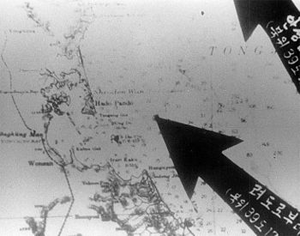 North Korean chart showing where they say they captured USS Pueblo
North Korean chart showing where they say they captured USS PuebloU.S. Navy authorities and the crew of Pueblo insist that before the capture, Pueblo was miles outside North Korean territorial waters. North Korea says the vessel was well within North Korean territory. The mission statement allowed her to approach within a nautical mile (1,852 m) of that limit. North Korea, however, describes a 50-nautical-mile (93 km) sea boundary even though international standards were 12 nautical miles (22 km) at the time.[12]
The North Korean vessels attempted to board Pueblo, but she was maneuvered to prevent this for over two hours. A submarine chaser then opened fire with a 57 mm cannon, killing one member of the crew. The smaller vessels fired machine guns into Pueblo, which then signaled compliance and began destroying sensitive material. The volume of material on board was so great that it was impossible to destroy it all. An NSA report quotes Lieutenant Steve Harris, the officer in charge of Pueblo's Naval Security Group Command detachment:
(...) we had retained on board the obsolete publications and had all good intentions of getting rid of these things but had not done so at the time we had started the mission. I wanted to get the place organized eventually and we had excessive numbers of copies on board (...)
and concludes
Only a small percentage of the total classified material aboard the ship was destroyed.
Radio contact between Pueblo and the Naval Security Group in Kamiseya, Japan, had been ongoing during the incident. As a result, Seventh Fleet command was fully aware of Pueblo's situation. Air cover was promised but never arrived. The Fifth Air Force had no aircraft on strip alert, and estimated a two to three-hour delay in launching aircraft. USS Enterprise was located 510 nautical miles (940 km) south of Pueblo, yet its four F-4B aircraft on alert were not equipped for an air-to-surface engagement. Enterprise's captain estimated that 1.5 hours (90 minutes) were required to get the converted aircraft into the air.[11] By the time President Lyndon B. Johnson was awakened, Pueblo had been captured and any rescue attempt would have been futile.
Pueblo followed the North Korean vessels as ordered, but then stopped immediately outside North Korean waters. She was again fired upon, and a sailor, fireman Duane Hodges, was killed. The ship was finally boarded at 05:55 UTC (2:55 pm local)[13] by men from a torpedo boat and a submarine chaser. Crew members had their hands tied and were blindfolded, beaten, and prodded with bayonets. Once Pueblo was in North Korean territorial waters, she was boarded again, this time by high-ranking North Korean officials.
The first official confirmation that the ship was in North Korean hands came five days later, 28 January 1968. Two days earlier a flight by a CIA A-12 Oxcart aircraft from the Project Black Shield squadron at Kadena, Okinawa flown by pilot Ronald Layton made three high altitude high speed flights over North Korea. When the aircraft's films were processed in the United States they showed Pueblo to be in the Wonsan harbor area surrounded by two North Korean vessels.[14]
There was dissent among government officials in the United States, regarding how to handle the situation. Congressman Mendel Rivers suggested that President Johnson issue an ultimatum for the return of Pueblo on penalty of nuclear attack, while Senator Gale McGee said the United States should wait for more information and not make "spasmodic response[s] to aggravating incidents".[15] According to Horace Busby, Special Assistant to President Johnson, the president's "reaction to the hostage taking was to work very hard here to keep down any demands for retaliation or any other attacks upon North Koreans", worried that rhetoric might result in the hostages being killed.[16]
Although American officials at the time assumed the seizure of Pueblo had been directed by the Soviet Union, it has emerged in recent years that North Korea acted alone and the incident actually harmed North Korea's relations with most of the Eastern Bloc.[17]
AftermathPueblo was taken into port at Wonsan and the crew was moved twice to prisoner of war (POW) camps. The crew reported upon release that they were starved and regularly tortured while in North Korean custody. This treatment allegedly turned worse[18] when the North Koreans realized that crewmen were secretly giving them "the finger" in staged propaganda photos.[19]
Commander Lloyd M. Bucher was psychologically tortured, such as being put through a mock firing squad in an effort to make him confess. Eventually the North Koreans threatened to execute his men in front of him, and Bucher relented and agreed to "confess to his and the crew's transgression." Bucher wrote the confession since a "confession" by definition needed to be written by the confessor himself. They verified the meaning of what he wrote, but failed to catch the pun when he said "We paean the DPRK [North Korea]. We paean their great leader Kim Il Sung".[20][21] (Bucher pronounced "paean" as "pee on.")[22]
Negotiations for the release of the crew took place at Panmunjom. At the same time, U.S. officials were concerned with conciliating the South Koreans, who expressed discontent about being left out of the negotiations. Richard A. Ericson, a political counselor for the American embassy in Seoul and operating officer for the Pueblo negotiations, notes in his oral history:
The South Koreans were absolutely furious and suspicious of what we might do. They anticipated that the North Koreans would try to exploit the situation to the ROK's disadvantage in every way possible, and they were rapidly growing distrustful of us and losing faith in their great ally. Of course, we had this other problem of how to ensure that the ROK would not retaliate for the Blue House Raid and to ease their growing feelings of insecurity. They began to realize that the DMZ was porous and they wanted more equipment and aid. So, we were juggling a number of problems.[23]
He also noted how the meetings at Panmunjom were usually unproductive, due to the particular negotiating style of the North Koreans:
As one example, we would go up with a proposal of some sort on the release of the crew and they would be sitting there with a card catalog... If the answer to the particular proposal we presented wasn’t in the cards, they would say something that was totally unresponsive and then go off and come back to the next meeting with an answer that was directed to the question. But there was rarely an immediate answer. That happened all through the negotiations. Their negotiators obviously were never empowered to act or speak on the basis of personal judgment or general instructions. They always had to defer a reply and presumably they went over it up in Pyongyang and passed it around and then decided on it. Sometimes we would get totally nonsensical responses if they didn’t have something in the card file that corresponded to the proposal at hand.[23]
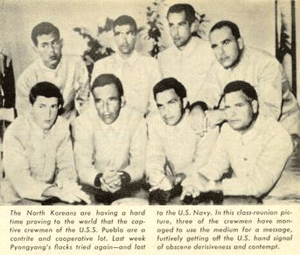 North Korean Propaganda Photograph of prisoners of USS Pueblo. Photo and explanation from the Time article that blew the Hawaiian Good Luck Sign secret. The sailors were flipping the middle finger, as a way to covertly protest their captivity in North Korea, and the propaganda on their treatment and guilt. The North Koreans for months photographed them without knowing the real meaning of flipping the middle finger, while the sailors explained that the sign meant good luck in Hawaii.
North Korean Propaganda Photograph of prisoners of USS Pueblo. Photo and explanation from the Time article that blew the Hawaiian Good Luck Sign secret. The sailors were flipping the middle finger, as a way to covertly protest their captivity in North Korea, and the propaganda on their treatment and guilt. The North Koreans for months photographed them without knowing the real meaning of flipping the middle finger, while the sailors explained that the sign meant good luck in Hawaii.Ericson and George Newman, the Deputy Chief of Mission in Seoul, wrote a telegram for the State Department in February 1968, predicting how the negotiations would play out:
What we said in effect was this: If you are going to do this thing at Panmunjom, and if your sole objective is to get the crew back, you will be playing into North Korea's hands and the negotiations will follow a clear and inevitable path. You are going to be asked to sign a document that the North Koreans will have drafted. They will brook no changes. It will set forth their point of view and require you to confess to everything they accuse you of... If you allow them to, they will take as much time as they feel they need to squeeze every damn thing they can get out of this situation in terms of their propaganda goals, and they will try to exploit this situation to drive a wedge between the U.S. and the ROK. Then when they feel they have accomplished all they can, and when we have agreed to sign their document of confession and apology, they will return the crew. They will not return the ship. This is the way it is going to be because this is the way it has always been.[23]
Following an apology, a written admission by the U.S. that Pueblo had been spying, and an assurance that the U.S. would not spy in the future, the North Korean government decided to release the 82 remaining crew members, although the written apology was preceded by an oral statement that it was done only to secure the release.[24] On 23 December 1968, the crew was taken by buses to the Korean Demilitarized Zone (DMZ) border with South Korea and ordered to walk south one by one across the "Bridge of No Return". Exactly eleven months after being taken prisoner, the Captain led the long line of crewmen, followed at the end by the Executive Officer, Lieutenant Ed Murphy, the last man across the bridge. The U.S. then verbally retracted the ransom admission, apology, and assurance. Meanwhile, the North Koreans blanked out the paragraph above the signature which read: "and this hereby receipts for eighty two crewmen and one corpse".[clarification needed]
Bucher and all the officers and crew subsequently appeared before a Navy Court of Inquiry. A court-martial was recommended for Bucher and the Officer in Charge of the Research Department, Lieutenant Steve Harris for surrendering without a fight and for failing to destroy classified material, but the Secretary of the Navy, John Chafee, rejected the recommendation, stating, "They have suffered enough." Commander Bucher was never found guilty of any indiscretions and continued his Navy career until retirement.[25]
In 1970, Bucher published an autobiographical account of the USS Pueblo incident entitled Bucher: My Story.[26] Bucher died in San Diego on 28 January 2004, at the age of 76. James Kell, a former sailor under his command, suggested that the injuries suffered by Bucher during his time in North Korea contributed to his death.[27]
USS Pueblo is still held by North Korea. In October 1999, it was towed from Wonsan on the east coast, around the Korean Peninsula, to the port of Nampo on the west coast. This required moving the vessel through international waters, and was undertaken just before the visit of U.S. presidential envoy James Kelly to the capital Pyongyang. After the stop at the Nampo shipyard Pueblo was relocated to Pyongyang and moored on the Taedong River near the spot that the General Sherman incident is believed to have taken place. In late 2012 Pueblo was moved again to the Botong River in Pyongyang next to a new addition to the Fatherland Liberation War Museum.[4]
Today, Pueblo remains the second-oldest commissioned ship in the U.S. Navy, behind the USS Constitution ("Old Ironsides"). Pueblo is one of only a few American ships to have been captured since the wars in Tripoli.
Breach of US Navy communications securityReverse engineering of communications devices on Pueblo allowed the North Koreans to share knowledge with the Soviet Union that led to the replication of those communications devices. This allowed the two nations access to the US Navy's communication systems until the late 1980s when the US Navy revised those systems. The seizure of Pueblo followed soon after US Navy warrant officer John Anthony Walker introduced himself to Soviet authorities, setting up the Walker spy ring. It has been argued that the seizure of Pueblo was executed specifically to capture the encryption devices aboard. Without them, it was difficult for the Soviets to make full use of Walker's information.[28][29][30]
In the communist campDocuments released from National Archives of Romania suggest it was the Chinese rather than the Soviets who actively encouraged the reopening of hostilities in Korea during 1968, promising North Korea vast material support should hostilities in Korea resume. Together with Blue House Raid, the Pueblo incident turned out to be part of an increasing divergence between the Soviet leadership and North Korea. Fostering a resumption of hostilities in Korea, allegedly, was seen in Beijing as a way to mend relations between North Korea and China, and pull North Korea back in the Chinese sphere of influence in the context of the Sino-Soviet split. After the (then secret) diplomatic efforts of the Soviets to have the American crew released fell on deaf ears in Pyongyang, Leonid Brezhnev publicly denounced North Korea's actions at the 8th plenary session of the 23rd Congress of the Communist Party of the Soviet Union.[31] In contrast, the Chinese (state controlled) press published declarations supportive of North Korea's actions in the Pueblo incident.[32]
Furthermore, Soviet archives reveal that the Soviet leadership was particularly displeased that North Korean leader Kim Il-sung had contradicted the assurances he previously gave Moscow that he would avoid a military escalation in Korea. Previously secret documents suggest the Soviets were surprised by the Pueblo incident, first learning of it in the press. The same documents reveal that the North Koreans also kept the Soviets completely in the dark regarding ongoing negotiations with the Americans for the crew's release, which was another bone of contention. The Soviet reluctance at a reopening of hostilities in Korea was partly motivated by the fact that they had a 1961 treaty with North Korea that obliged them to intervene[33] in case the latter got attacked. Brezhnev however had made it clear in 1966 that just as in the case of the similar treaty they had with China, the Soviets were prepared to ignore it rather than go to all-out war with the United States.[34]:12-15
Given that Chinese and North Korean archives surrounding the incident remain secret, Kim Il-sung's intentions cannot be known with certainty. The Soviets revealed however that Kim Il-sung sent a letter to Alexei Kosygin on 31 January 1968 demanding further military and economic aid, which was interpreted by the Soviets as the price they would have to pay to restrain Kim Il-sung's bellicosity. Consequently, Kim Il-sung was personally invited to Moscow, but he refused to go in person owing to "increased defense preparations" he had to personally attend to, sending instead his defense minister, Kim Ch’ang-bong, who arrived on 26 February 1968. During a long meeting with Brezhnev, the Soviet leader made it clear that they were not willing to go to war with the United States, but agreed to an increase in subsidies for North Korea, which did happen in subsequent years.[34]:15-18
Aftermath: capture and repatriation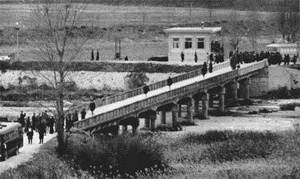 Pueblo's crew being released by the North Koreans across the Bridge of No Return in the Joint Security Area of the DMZ (De-militarized Zone) in Panmunjom, Korea on 23 December 1968.
Pueblo's crew being released by the North Koreans across the Bridge of No Return in the Joint Security Area of the DMZ (De-militarized Zone) in Panmunjom, Korea on 23 December 1968. 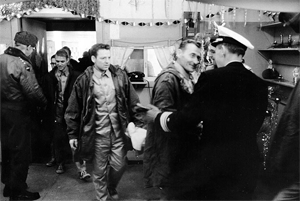 Crew of USS Pueblo upon release on 23 December 1968.
Crew of USS Pueblo upon release on 23 December 1968. 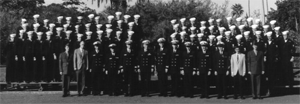 Official Navy photograph of Pueblo's crew taken on the grounds of the Balboa Naval Hospital in San Diego shortly after their arrival. Timeline of negotiations
Official Navy photograph of Pueblo's crew taken on the grounds of the Balboa Naval Hospital in San Diego shortly after their arrival. Timeline of negotiationsWith Major General Pak Chung-kuk representing North Korea (DPRK) and U.S. Navy Rear Admiral John Victor Smith representing the United States until April 1968, at which point he is replaced by U.S. Army Major General Gilbert H. Woodward. Timeline and quotations are taken from Matter of Accountability by Trevor Armbrister.[35]
Date / Chief Negotiator / Event / Position of respective government
23 January 1968 (around noon local time) / -- / Pueblo is intercepted by North Korean forces close to the North Korean port city of Wonsan.
24 January 1968 (11am local time) / Admiral Smith / Protests the "heinous" Blue House raid and subsequently plays a tape of a captured North Korean soldier's "confession" ... "I want to tell you, Pak, that the evidence against you North Korean Communists is overwhelming ... I now have one more subject to raise which is also of an extremely serious nature. It concerns the criminal boarding and seizure of ... Pueblo in international waters. It is necessary that your regime do the following: one, return the vessel and crew immediately; two, apologize to the Government of the United States for this illegal action. You are advised that the United States reserves the right to ask for compensation under international law."
24 January 1968 (11am local time) / General Pak / "Our saying goes, 'A mad dog barks at the moon', ... At the two hundred and sixtieth meeting of this commission held four days ago, I again registered a strong protest with your side against having infiltrated into our coastal waters a number of armed spy boats ... and demanded you immediately stop such criminal acts ... this most overt act of the US imperialist aggressor forces was designed to aggravate tension in Korea and precipitate another war of aggression...
The United States must admit that Pueblo entered North Korean waters, must apologize for this intrusion, and must assure the Democratic Peoples Republic of Korea that such intrusions will never happen again. Admit, Apologize and Assure (the Three A's)."
4 March 1968 / -- / Names of dead and wounded prisoners are provided by the DPRK.
late April 1968 / -- / Admiral Smith is replaced by US Army Major General Gilbert H. Woodward as chief negotiator.
8 May 1968 / -- / General Pak presents General Woodward with the document by which the United States would admit that Pueblo had entered the DPRK's waters, would apologize for the intrusion and assure the DPRK that such an intrusion would never happen again. It cited the "Three A's" as the only basis for a settlement and went on to denounce the United States for a whole host of other "crimes".
29 August 1968 / General Woodward / A proposal drafted by US Under Secretary of State Nicholas Katzenbach [the "overwrite" strategy] is presented. "If I acknowledge receipt of the crew on a document satisfactory to you as well as to us, would you then be prepared to release all of the crew?"
29 August 1968 / General Pak / "Well, we have already told you what you must sign ..."
17 September 1968 /General Pak / "If you will sign our document, something might be worked out..."
30 September 1968 / General Pak / "If you will sign the document, we will at the same time turn over the men"
30 September 1968 / General Woodward / "We do not feel it is just to sign a paper saying we have done something we haven't done. However, in the interest of reuniting the crew with their families, we might consider an 'acknowledge receipt'"
10 October 1968 / General Woodward / (demonstrating to General Pak the nature of the 'signing') "I will write here that I hereby acknowledge receipt of eighty-two men and one corpse..."
10 October 1968 / General Pak / "You are employing sophistries and petty stratagems to escape responsibility for the crimes which your side committed..."
23 October 1968 / -- / The "overwrite" proposal is again set out by General Woodward and General Pak again denounces it as a "petty strategem".
31 October 1968 / General Woodward / "If I acknowledge receipt of the crew on a document satisfactory to you as well as to us, would you then be prepared to release all of the crew?"
31 October 1968 / General Pak / "The United States must admit that Pueblo had entered North Korean waters, must apologize for this intrusion, and must assure the Democratic Peoples Republic of Korea that this will never happen again."
17 December 1968 / General Woodward / Explains a proposal by State Department Korea chief James Leonard: the "prior refutation" scheme. The United States would agree to sign the document but General Woodward would then verbally denounce it once the prisoners had been released.
17 December 1968 / General Pak / [following a 50min recess] "I note that you will sign my document ... we have reached agreement."
23 December 1968 / -- / General Woodward on behalf of the United States signs the Three A's document and the DPRK at the same time allows Pueblo's prisoners to return to US custody.
Tourist attractionPueblo is a tourist attraction in Pyongyang, North Korea, since being moved to the Taedong River.[36] Pueblo used to be anchored at the spot where it is believed the General Sherman incident took place in 1866. In late November 2012 Pueblo was moved from the Taedong river dock to a casement on the Botong river next to the new Fatherland War of Liberation Museum. The ship was renovated and made open to tourists with an accompanying video[37] of the North Korean perspective in late July 2013. To commemorate the anniversary of the Korean War, the ship had a new layer of paint added.[38] As of April 2015, the museum is moored and on display at the Pyongyang Victorious War Museum. Visitors are allowed to board the ship and see its secret code room and crew artifacts.[39]
The museum's position is 39°02.26 N 125°44.23 E
USS Pueblo in Pyongyang, North Korea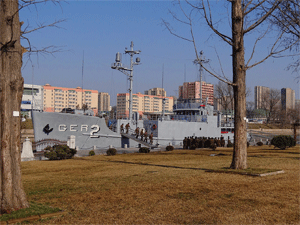 Offer to repatriate
Offer to repatriateDuring an August 2005 diplomatic session in North Korea, former U.S. Ambassador to South Korea Donald Gregg received verbal indications from high-ranking North Korean officials that the state would be willing to repatriate Pueblo to United States authorities, on the condition that a prominent U.S. government official, such as the Secretary of State, come to Pyongyang for high level talks. While the U.S. government has publicly stated on several occasions that the return of the still commissioned Navy vessel is a priority, the current overall situation of U.S. and North Korean relations makes such an official state visit unlikely.[40]
LawsuitFormer Pueblo crew members William Thomas Massie, Dunnie Richard Tuck, Donald Raymond McClarren, and Lloyd Bucher sued the North Korean government for the abuse they suffered at its hands during their captivity. North Korea did not respond to the suit. In December 2008, U.S. District Judge Henry H. Kennedy, Jr., in Washington, D.C., awarded the plaintiffs $65 million in damages, describing their ill treatment by North Korea as "extensive and shocking."[41] The plaintiffs, as of October 2009, were attempting to collect the judgment from North Korean assets frozen by the U.S. government.[42]
AwardsPueblo has earned the following awards –
As FS-344 American Campaign Medal World War II Victory Medal National Defense Service Medal
As USS Pueblo Bronze starBronze star
Combat Action Ribbon | National Defense Service Medal with two stars
Armed Forces Expeditionary Medal Korea Defense Service Medal
As for the crew members, they did not receive full recognition for their involvement in the incident until decades later. In 1988, the military announced it would give out Prisoner of War medals to those captured in the nation’s conflicts. While thousands of American prisoners of war were awarded medals, the crew members of Pueblo did not receive them. Instead, they were classified as "detainees". It was not until Congress passed a law overturning this decision that the medals were awarded; the crew finally received the medals at San Diego in May 1990.[25]
Representation in popular cultureThe Pueblo incident was dramatically depicted in the critically acclaimed 1973 ABC Theater televised production Pueblo. Hal Holbrook starred as Captain Lloyd Bucher. The two-hour drama was nominated for three Emmy Awards, winning two.[43][44]
An earlier British dramatization for the 1970 season of ITV Playhouse starred Ray McAnally as Bucher.[45]
In June 2014, satirical military news site Duffel Blog ran a story suggesting President Obama would trade Seoul for the return of Pueblo.[46]
In Season 4, episode 9 of the TV series Archer, the main character Sterling Archer exclaims, "This is for the Pueblo!" while fighting a group of North Korean spies.
Blind Robert Ward recorded the song "The Pueblo's Crew" in January 1969. It was released as Fonotone Records 6901.[47]
"Ride Captain Ride" a song recorded by the American rock band Blues Image in 1970 had a lot of fans thinking this song was based on Pueblo, however the lyrics state "73 men sailed off", instead of 83.
See alsoemblem United States Navy portal
1969 EC-121 shootdown incident
Korean DMZ Conflict (1966–69)
List of museums in North Korea
Other conflicts:Gulf of Tonkin incident
Hainan Island incident
Mayaguez incident
USS Liberty incident
General:Technical research ship
List of hostage crises
References1. "Pueblo Incident". "Naenara" News from South Korea. Archived from the original on 27 May 2015.
2. ^Schindler, John R. "A Dangerous Business: The U.S. Navy and National Reconnaissance During the Cold War" (PDF). p. 9. Retrieved 24 June 2013.
3. "USS Pueblo – AGER-2". Naval Vessel Register. Retrieved 11 June 2009.
4. MacClintock, R. "USS Pueblo Today". USS Pueblo Veteran's Association.
5. "List of active ships". Naval Vessel Register. NAVSEA Shipbuilding Support Office. Retrieved 23 May 2013.
6. "U.S. Army cargo ship FP-344 (1944–1966), later renamed FS-344". Naval History and Heritage Command Online Library of Selected Images.
7. "World War II Coast Guard Manned U.S. Army Freight and Supply Ship Histories:FS-344". U.S. Coast Guard.
8. "Attacked by North Koreans". USS Pueblo Veteran's Association. Archived from the original on 28 August 2008. Retrieved 11 June 2009.
9. "USS Pueblo AGER 2: Background Information" (PDF). National Security Agency. p. 10. Retrieved 13 June 2013.
10. "USS Pueblo". Dictionary of American Naval Fighting Ships.
11. Newton, Robert E. (1992). "The Capture of the USS Pueblo and Its Effect on SIGINT Operations" (PDF). U.S. Cryptologic History, Special Series, Crisis Collection, Vol. 7, National Security Agency (NSA). Retrieved 19 February 2010.
12. "Questions of international law raised by the seizure of the U.S.S. Pueblo",Proceedings of the American Society of International Law: at its sixty third annual meeting held at Washington, D.C., 24–26 April 1969. American Society of International Law.
13. "North Korean Transmissions from January 1968: Chronology" (PDF). National Security Agency (NSA). 1968. Retrieved 26 June 2013.
14. Mobley, Richard A. (2003). Flash Point North Korea. Naval Institute Press. ISBN 978-1-55750-403-6.
15. "N. Korea Seize U.S. Ship, 1968 Year in Review". UPI.com. 1968. Retrieved 11 June 2009.
16. "Interview with Horace W. Busby, 1981". WGBH Media Library & Archives. 24 April 1981. Retrieved 9 November 2010.
17. Lerner, Mitchell; Shin, Jong-Dae (March 2012). "New Romanian Evidence on the Blue House Raid and the USS Pueblo Incident. NKIDP e-Dossier No. 5". Woodrow Wilson International Center for Scholars. Retrieved 23 April 2012.
18. Iredale, Harry; McClintock, Ralph. "Compound 2 'The Farm'". USS Pueblo Veteran's Association. Archived from the original on 30 September 2010. Retrieved 30 September 2010. The treatment would become better or worse depending upon the day, the week, the guard, the duty officer or the situation.
19. Stu, Russell. "The Digit Affair". USS Pueblo Veteran's Association. Archived from the original on 30 September 2010. Retrieved 30 September 2010. The finger became an integral part of our anti-propaganda campaign. Any time a camera appeared, so did the fingers.
20. "Bush lauded for handling of EP-3 incident". WorldNetDaily. Archived from the original on 1 February 2009.
21. "End of North Korea?". The Palm Beach Times.
22. Cheevers, Jack (2013). Act of War: Lyndon Johnson, North Korea, and the Capture of the Spy Ship Pueblo. Penguin. ISBN 978-0-45146-619-8.
23. Kennedy, Charles S. (27 March 1995). "The USS Pueblo Incident – Assassins in Seoul, A Spy Ship Captured". The Association for Diplomatic Studies and Training: Foreign Affairs Oral History Project. Retrieved 20 February 2013.
24. Probst, Reed R. (16 May 1977). "Negotiating With the North Koreans: The U.S. Experience at Panmunjom" (PDF). Carlisle Barracks, Pennsylvania: U.S. Army War College. Archived from the original (PDF) on 25 July 2008. Retrieved 17 December 2009.
25. "Remembering the Pueblo and North Korea". The San Diego Union-Tribune. 19 December 2011. Retrieved 18 October 2014.
26. Bucher, Lloyd M.; Mark Rascovich (1970). Bucher: My Story. Doubleday & Company. ISBN 0385072449.
27. "Lloyd Bucher, captain of the Pueblo, buried in San Diego". North County Times. 3 February 2004. Retrieved 11 June 2009.
28. "Crypto gear, John Walker and the History Channel". USS Pueblo Veteran's Association.
29. Heath, Laura J. Analysis of the Systemic Security Weaknesses of the U.S. Navy Fleet Broadcasting System, 1967–1974, as Exploited by CWO John Walker(PDF) U.S. Army Command and General Staff College Master's Thesis. 2005.
30. Prados, John. The Navy's Biggest Betrayal. Naval History 24, no. 3 (June 2010): 36.
31. "New Romanian Evidence on the Blue House Raid and the USS Pueblo Incident". 20 April 2012.
32. Freeman, C. (30 June 2015). "China and North Korea: Strategic and Policy Perspectives from a Changing China". Springer – via Google Books.
33.
https://www.documentcloud.org/documents ... utual.html34. Radchenko, Sergey S. "The Soviet Union and the North Korean Seizure of the USS Pueblo: Evidence from Russian Archives" (PDF). Cold War International History Project. Washington, D.C.: Woodrow Wilson International Center for Scholars.
35. Armbrister, Trevor (1971). Matter of Accountability. Barrie & Jenkins. ISBN 978-0214652141.
36. Gluck, Caroline. "North Korea drags its feet". BBC News. Retrieved 23 January2007.
37. "North Korean DPRK Liberation War Museum Video: Pueblo, U.S. Armed Spy Ship". Ryugyong Programming Center, the Democratic People’s Republic of Korea's media website.
38. "North Korea to put US spy ship captured in 1968 on display". The Guardian. 25 July 2013. Retrieved 25 July 2013.
39. Donenfeld, Jeffrey. "Full report: Visit to North Korea and the Pyongyang marathon". Jeffreydonenfeld.com. Retrieved 19 August 2015.
40. "Saturday feature: Old flag for an old spy ship". Shipping Times. Archived from the original on 1 February 2009. Retrieved 11 June 2009.
41. Washington Post, "Damages Awarded in USS Pueblo Case", 31 December 2008, p. 5.
42. Wilber, Del Quentin (8 October 2009). "Hell Hath a Jury: North Korea Tortured the Crew of USS Pueblo in 1968. 4 Victims Fought for Solace in the Courts". Washington Post. p. C1.
43. "Pueblo". IMDb. 29 March 1973.
44. "Pueblo – Trailer – Cast – Showtimes". The New York Times.
45. "The Pueblo Affair". IMDb. 19 January 1970.
46. Jay-B (7 June 2014). "Obama Trades Seoul To North Korea For Return Of USS Pueblo". Duffel Blog. Retrieved 10 April 2015.
47. The song was re-released in 2005 on the compilation album Fonotone Records: Frederick, Maryland (Dust-to-Digital DTD-03).
Sources• This article incorporates text from the public domain Dictionary of American Naval Fighting Ships. The entry can be found here.
• This article includes information collected from the Naval Vessel Register, which, as a U.S. government publication, is in the public domain. The entry can be found here.
• NKIDP: Crisis and Confrontation on the Korean Peninsula: 1968–1969, A Critical Oral History
• USS PUEBLO TODAY

